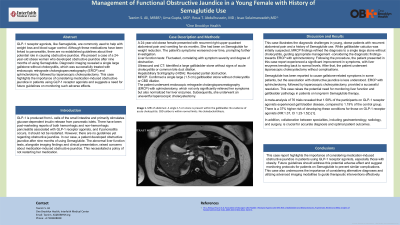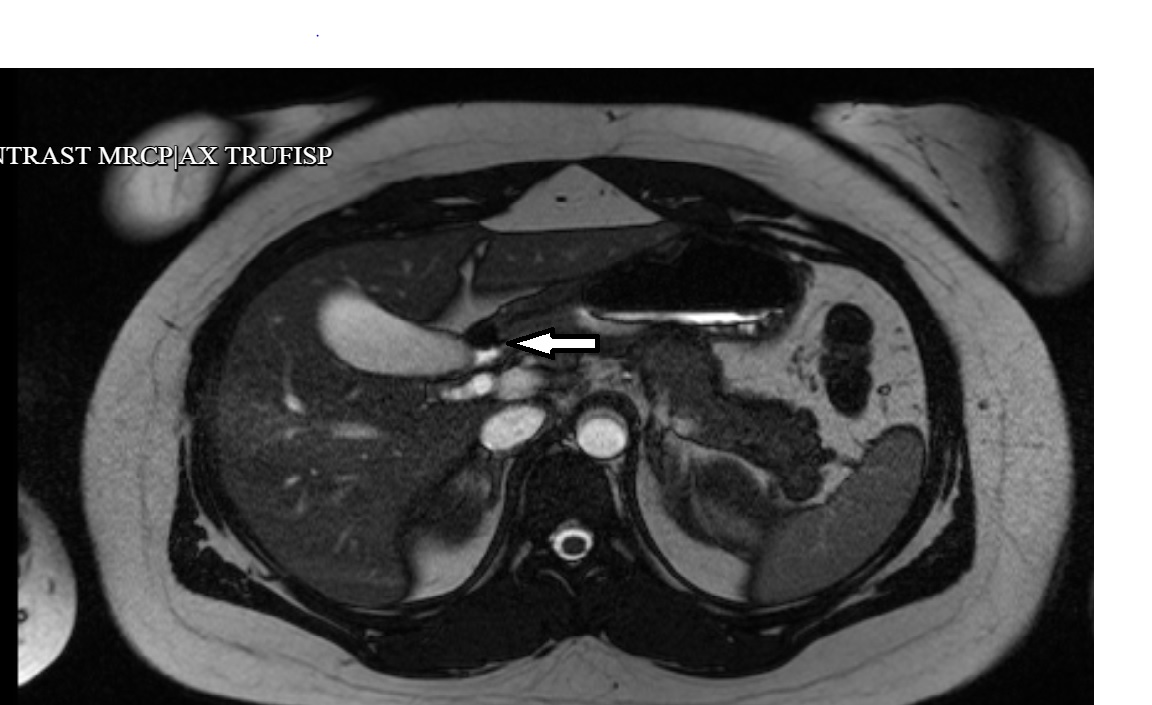Monday Poster Session
Category: Liver
P3112 - Management of Functional Obstructive Jaundice in a Young Female With History of Semaglutide Use
Monday, October 28, 2024
10:30 AM - 4:00 PM ET
Location: Exhibit Hall E

Has Audio

Tasnim Ali, MBBS
One Brooklyn Health-Interfaith Medical Center
Brooklyn, NY
Presenting Author(s)
Tasnim S. Ali, MBBS1, Uma Gupta, MD1, Issac Solaimanzadeh, MD1, Roua T. Abdulhussein, MD2
1One Brooklyn Health-Interfaith Medical Center, Brooklyn, NY; 2Al-Mustansiriyah University, Brooklyn, NY
Introduction: GLP-1 is produced from L cells of the small intestine and primarily stimulates glucose-dependent insulin release from pancreatic islets. There have been post-marketing reports of both hemorrhagic and non-hemorrhagic pancreatitis associated with GLP-1 receptor agonists and if pancreatitis occurs and should not be restarted. However, there are no guidelines yet regarding obstructive jaundice. In our case, a patient developed obstructive jaundice after 9 months of using Semaglutide. After three months following ERCP and endoscopic cholecystectomy, her abnormal liver function tests raised concerns about medication-induced obstructive jaundice. This necessitated a policy of not restarting her medication.
Case Description/Methods: A 24-year-old female presented with recurrent right upper abdominal pain and vomiting for six months. She is obese and was prescribed Semaglutide for weight reduction. The patient's abdominal pain and vomiting were severe and persistent during this presentation. Initial evaluation suggested calculus of the gallbladder without cholecystitis, with functional obstruction. Liver function tests showed fluctuating levels, correlating with the severity of symptoms and degree of obstruction. Ultrasound and computed tomography (CT) confirmed a large gallbladder stone without obstruction. However, Hepatobiliary scintigraphy (HIDA) demonstrated partial obstruction. Magnetic resonance cholangiopancreatography (MRCP) revealed a single large (1.5 cm) stone without evidence of cholecystitis or common bile duct (CBD) dilatation.
Considering the diagnostic findings, the patient underwent endoscopic retrograde cholangiopancreatography (ERCP) with sphincterotomy on 2/26/2024. Following the procedure, the patient experienced a significant improvement in symptoms, with liver enzymes trending back to normal levels. After that, the patient underwent laparoscopic cholecystectomy without complications.
Discussion: This case highlights the diagnostic challenges associated with recurrent abdominal pain in young patients with obesity with history of Semaglutide use which was reported to cause similar symptoms in some case studies. Despite initial suspicion of gallbladder calculus, MRCP revealed a single large stone without cholecystitis, guiding the therapeutic approach towards ERCP with sphincterotomy. The timely intervention resulted in significant symptom relief and normalization of liver function tests.

Note: The table for this abstract can be viewed in the ePoster Gallery section of the ACG 2024 ePoster Site or in The American Journal of Gastroenterology's abstract supplement issue, both of which will be available starting October 27, 2024.
Disclosures:
Tasnim S. Ali, MBBS1, Uma Gupta, MD1, Issac Solaimanzadeh, MD1, Roua T. Abdulhussein, MD2. P3112 - Management of Functional Obstructive Jaundice in a Young Female With History of Semaglutide Use, ACG 2024 Annual Scientific Meeting Abstracts. Philadelphia, PA: American College of Gastroenterology.
1One Brooklyn Health-Interfaith Medical Center, Brooklyn, NY; 2Al-Mustansiriyah University, Brooklyn, NY
Introduction: GLP-1 is produced from L cells of the small intestine and primarily stimulates glucose-dependent insulin release from pancreatic islets. There have been post-marketing reports of both hemorrhagic and non-hemorrhagic pancreatitis associated with GLP-1 receptor agonists and if pancreatitis occurs and should not be restarted. However, there are no guidelines yet regarding obstructive jaundice. In our case, a patient developed obstructive jaundice after 9 months of using Semaglutide. After three months following ERCP and endoscopic cholecystectomy, her abnormal liver function tests raised concerns about medication-induced obstructive jaundice. This necessitated a policy of not restarting her medication.
Case Description/Methods: A 24-year-old female presented with recurrent right upper abdominal pain and vomiting for six months. She is obese and was prescribed Semaglutide for weight reduction. The patient's abdominal pain and vomiting were severe and persistent during this presentation. Initial evaluation suggested calculus of the gallbladder without cholecystitis, with functional obstruction. Liver function tests showed fluctuating levels, correlating with the severity of symptoms and degree of obstruction. Ultrasound and computed tomography (CT) confirmed a large gallbladder stone without obstruction. However, Hepatobiliary scintigraphy (HIDA) demonstrated partial obstruction. Magnetic resonance cholangiopancreatography (MRCP) revealed a single large (1.5 cm) stone without evidence of cholecystitis or common bile duct (CBD) dilatation.
Considering the diagnostic findings, the patient underwent endoscopic retrograde cholangiopancreatography (ERCP) with sphincterotomy on 2/26/2024. Following the procedure, the patient experienced a significant improvement in symptoms, with liver enzymes trending back to normal levels. After that, the patient underwent laparoscopic cholecystectomy without complications.
Discussion: This case highlights the diagnostic challenges associated with recurrent abdominal pain in young patients with obesity with history of Semaglutide use which was reported to cause similar symptoms in some case studies. Despite initial suspicion of gallbladder calculus, MRCP revealed a single large stone without cholecystitis, guiding the therapeutic approach towards ERCP with sphincterotomy. The timely intervention resulted in significant symptom relief and normalization of liver function tests.

Figure: MRI of abdomen: A single 1.5 cm stone is present within the gallbladder. No evidence of
acute cholecystitis. CBD caliber is within normal limits. No choledocholithiasis.
acute cholecystitis. CBD caliber is within normal limits. No choledocholithiasis.
Note: The table for this abstract can be viewed in the ePoster Gallery section of the ACG 2024 ePoster Site or in The American Journal of Gastroenterology's abstract supplement issue, both of which will be available starting October 27, 2024.
Disclosures:
Tasnim Ali indicated no relevant financial relationships.
Uma Gupta indicated no relevant financial relationships.
Issac Solaimanzadeh indicated no relevant financial relationships.
Roua Abdulhussein indicated no relevant financial relationships.
Tasnim S. Ali, MBBS1, Uma Gupta, MD1, Issac Solaimanzadeh, MD1, Roua T. Abdulhussein, MD2. P3112 - Management of Functional Obstructive Jaundice in a Young Female With History of Semaglutide Use, ACG 2024 Annual Scientific Meeting Abstracts. Philadelphia, PA: American College of Gastroenterology.

